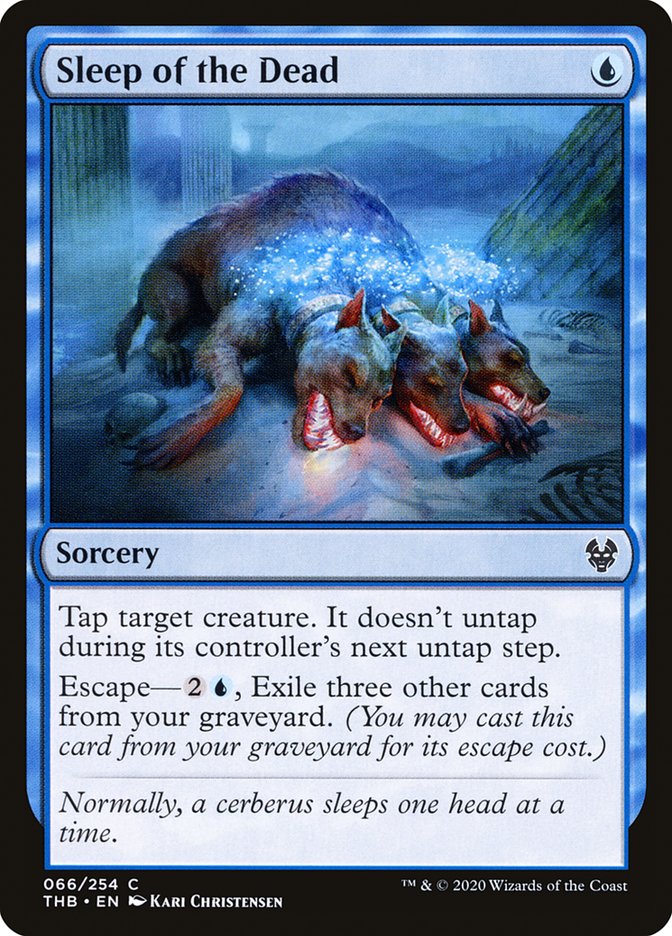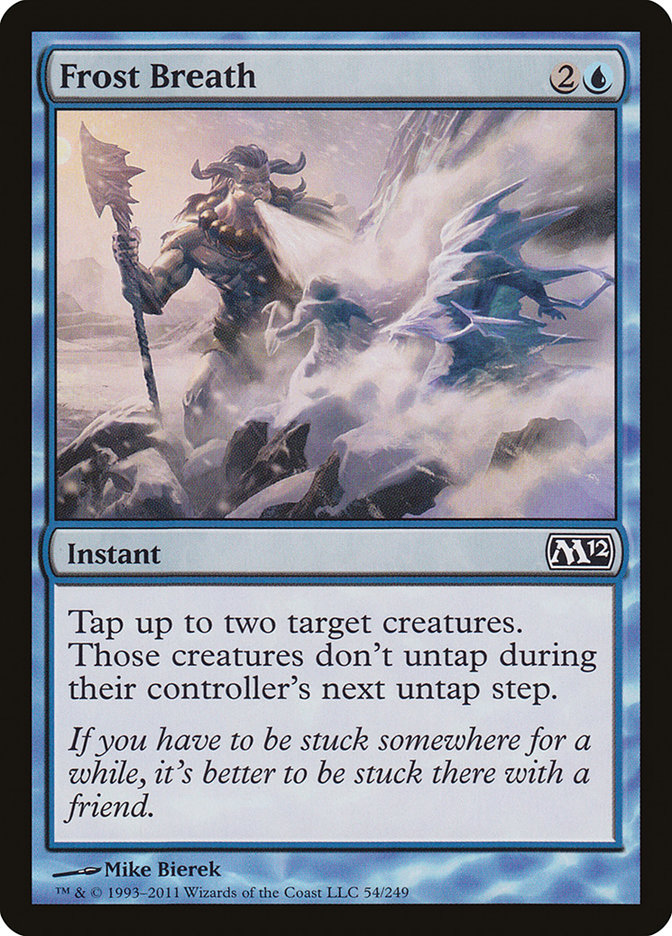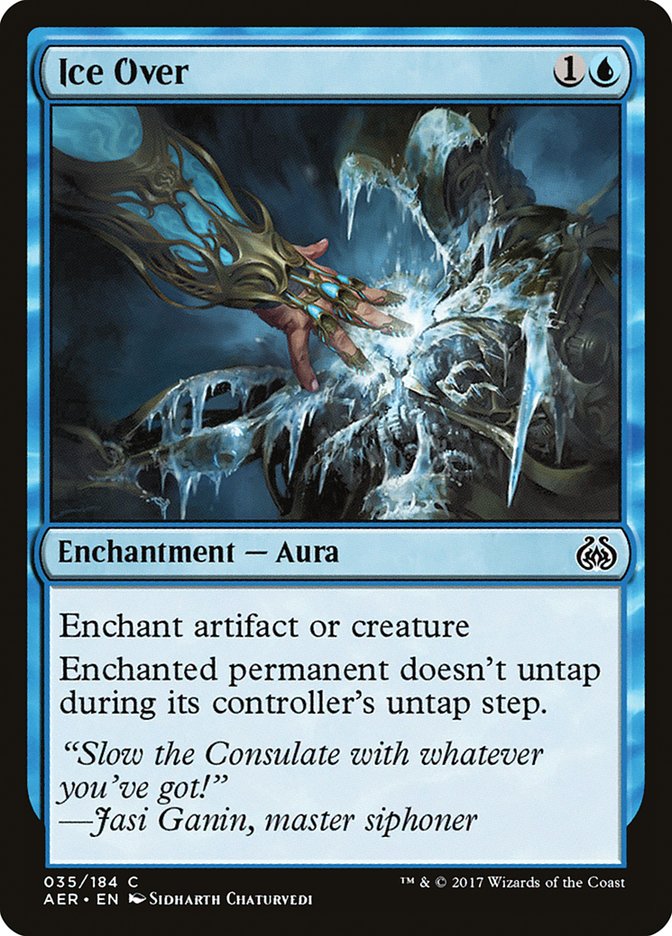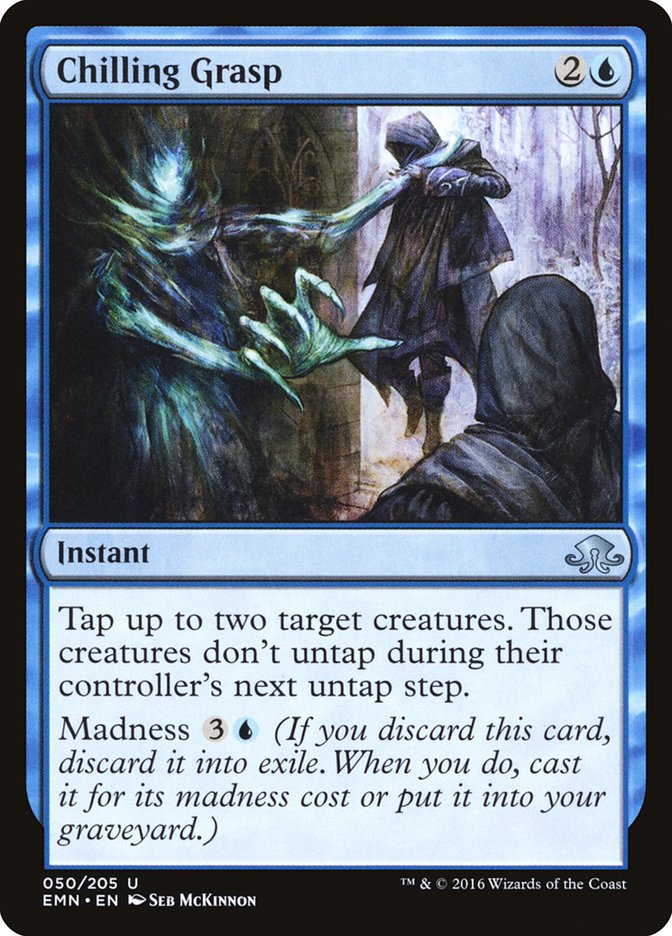Sleep of the Dead MTG Card
| Mana cost | |
| Converted mana cost | 1 |
| Rarity | Common |
| Type | Sorcery |
| Abilities | Escape |
| Released | 2020-01-24 |
| Set symbol | |
| Set name | Theros Beyond Death |
| Set code | THB |
| Number | 66 |
| Frame | 2015 |
| Layout | Normal |
| Border | Black |
| Illustred by | Kari Christensen |
Text of card
Tap target creature. It doesn't untap during its controller's next untap step. Escape—, Exile three other cards from your graveyard. (You may cast this card from your graveyard for its escape cost.)
Normally, a cerberus sleeps one head at a time.
Cards like Sleep of the Dead
Sleep of the Dead stands as an intriguing control option for blue deck players in Magic: The Gathering. It shares a core gameplay function with Frost Breath, which notably taps up to two target creatures, preventing them from untapping during the controllers’ next untap step. Sleep of the Dead provides a similar temporary stalling tactic, albeit targeting a single creature, yet it has the added flexibility of being repeatable thanks to its escape mechanic, giving it an edge in longer bouts.
Ice Over is another card that presents a comparable freezing effect, this time attaching to the target creature or vehicle and neutralizing it for as long as Ice Over remains on the battlefield. While it lacks the escape repeatibility, it offers a more permanent solution to dealing with threats. Conversely, there’s Chilling Grasp, which taps up to two creatures and skips their next untap phase. This card, while it affects multiple creatures, does not offer the recursive utility of Sleep of the Dead’s escape ability.
In evaluating control options, Sleep of the Dead’s place is cemented as a tactical spell that can become a recurring nuisance, especially in limited formats. Its synergy with graveyard strategies and repeated use potential make it a versatile choice for MTG players who enjoy maintaining a steady tempo and controlling the board.
Card Pros
Card Advantage: Sleep of the Dead has the potential to be a multi-faceted tool for card advantage in the right deck. By tapping a creature your opponent controls, you can hinder their plans and gain an edge in creature combat, indirectly leading to card efficiency if your untapped creatures can take out their tapped threat.
Resource Acceleration: Although Sleep of the Dead itself does not directly accelerate your resources, by stalling your opponent’s creatures, it can give you the crucial time needed to set up your own board and access your resources more effectively. This can be especially impactful when you need just one more turn to deploy a game-changing spell or creature.
Instant Speed: The ability to cast Sleep of the Dead at instant speed gives you significant flexibility. You can decide the best moment during your opponent’s turn to tap their creature, potentially disrupting their combat strategies or timing it right before a pivotal turn where freeing up your mana for other instant responses is crucial.
Card Cons
Discard Requirement: Sleep of the Dead prompts you to tap a creature only if you have a card to exile from your graveyard, potentially leaving you at a disadvantage if your graveyard is empty or contains cards you wish to keep.
Specific Mana Cost: The casting cost of Sleep of the Dead calls for both blue mana and one of any other color. This requirement confines the card’s usage mainly within blue-inclined decks, potentially restricting its overall flexibility across various deck types.
Comparatively High Mana Cost: While Sleep of the Dead’s ability might seem cost-effective, its mana cost is significant for a single-target tap effect. When considering deck construction, players may find other tempo options that provide more impact for a similar or lower investment of resources.
Reasons to Include Sleep of the Dead in Your Collection
Versatility: Sleep of the Dead is a card with broad utility, fitting well into decks that aim to control the board. With its low cost and instant-speed playability, it enables you to tap down a target creature at a crucial moment, perhaps interrupting your opponents’ combat strategies or delaying key creatures from contributing to their game plan.
Combo Potential: This card shines in decks built around tapping and untapping mechanics. It can be a cog in a larger machine, working with cards that benefit from creatures being tapped or ones that allow you to untap it for repeated use, thus providing more value each turn and creating unexpected synergies in your gameplay.
Meta-Relevance: In a game where tempo can be the deciding factor, Sleep of the Dead holds its ground. It’s particularly useful if the meta is saturated with aggressive creature-based strategies. Slowing down an opponent’s offensive or hindering their blocker can swing the match in your favor, making it a practical inclusion in many blue-focused control decks.
How to beat
Sleep of the Dead is a control card that can temporarily stall an opposing creature, playing a pivotal role in a close game of Magic the Gathering. To counteract this card, the key is maintaining a diverse board presence. Having multiple threats means that the tap effect of Sleep of the Dead loses some potency. Moreover, utilizing cards with untap abilities can swiftly negate the effect and regain the initiative, overturning the temporary disadvantage.
Another strategic move is employing instant speed spells to bolster your creatures and protect them from being targeted. Enchantments with hexproof capabilities safeguard your key creatures, making them ineligible targets for such control tactics. Additionally, you can leverage cards that operate well from the graveyard to ensure that even if your creature is incapacitated, you can still utilize it for other strategic advantages or recur it back to the battlefield.
The efficiency of beating Sleep of the Dead comes down to being prepared and adaptable. Building your deck to either mundane or gradual tap down effects ensures you maintain a tempo that one Sleep of the Dead cannot easily disrupt. Flexibility and protection are your allies in facing down control strategies that seek to put your forces to slumber.
Where to buy
If you're looking to purchase Sleep of the Dead MTG card by a specific set like Theros Beyond Death, there are several reliable options to consider. One of the primary sources is your local game store, where you can often find booster packs, individual cards, and preconstructed decks from current and some past sets. They often offer the added benefit of a community where you can trade with other players.
For a broader inventory, particularly of older sets, online marketplaces like TCGPlayer, Card Kingdom and Card Market offer extensive selections and allow you to search for cards from specific sets. Larger e-commerce platforms like eBay and Amazon also have listings from various sellers, which can be a good place to look for sealed product and rare finds.
Additionally, Magic’s official site often has a store locator and retailer lists for finding Wizards of the Coast licensed products. Remember to check for authenticity and the condition of the cards when purchasing, especially from individual sellers on larger marketplaces.
Below is a list of some store websites where you can buy the Sleep of the Dead and other MTG cards:
 BUY NOW
BUY NOW BurnMana is an official partner of TCGPlayer
- eBay
- Card Kingdom
- Card Market
- Star City Games
- CoolStuffInc
- MTG Mint Card
- Hareruya
- Troll and Toad
- ABU Games
- Card Hoarder Magic Online
- MTGO Traders Magic Online
See MTG Products
Legalities
Magic the Gathering formats where Sleep of the Dead has restrictions
| Format | Legality |
|---|---|
| Historicbrawl | Legal |
| Historic | Legal |
| Legacy | Legal |
| Paupercommander | Legal |
| Oathbreaker | Legal |
| Gladiator | Legal |
| Pioneer | Legal |
| Commander | Legal |
| Modern | Legal |
| Pauper | Legal |
| Vintage | Legal |
| Duel | Legal |
| Explorer | Legal |
| Penny | Legal |
| Timeless | Legal |
Rules and information
The reference guide for Magic: The Gathering Sleep of the Dead card rulings provides official rulings, any errata issued, as well as a record of all the functional modifications that have occurred.
| Date | Text |
|---|---|
| 2020-01-24 | After an escaped spell resolves, it returns to its owner’s graveyard if it’s not a permanent spell. If it is a permanent spell, it enters the battlefield and will return to its owner’s graveyard if it dies later. Perhaps it will escape again—good underworld security is so hard to come by these days. |
| 2020-01-24 | Escape’s permission doesn’t change when you may cast the spell from your graveyard. |
| 2020-01-24 | If a card has multiple abilities giving you permission to cast it, such as two escape abilities or an escape ability and a flashback ability, you choose which one to apply. The others have no effect. |
| 2020-01-24 | If a card with escape is put into your graveyard during your turn, you’ll be able to cast it right away if it’s legal to do so, before an opponent can take any actions. |
| 2020-01-24 | If you cast a spell with its escape permission, you can’t choose to apply any other alternative costs or to cast it without paying its mana cost. If it has any additional costs, you must pay those. |
| 2020-01-24 | Once you begin casting a spell with escape, it immediately moves to the stack. Players can’t take any other actions until you’re done casting the spell. |
| 2020-01-24 | Sleep of the Dead can target a creature that’s already tapped. That creature won’t untap during its controller’s next untap step. |
| 2020-01-24 | To determine the total cost of a spell, start with the mana cost or alternative cost you’re paying (such as an escape cost), add any cost increases, then apply any cost reductions. The converted mana cost of the spell remains unchanged, no matter what the total cost to cast it was and no matter whether an alternative cost was paid. |



